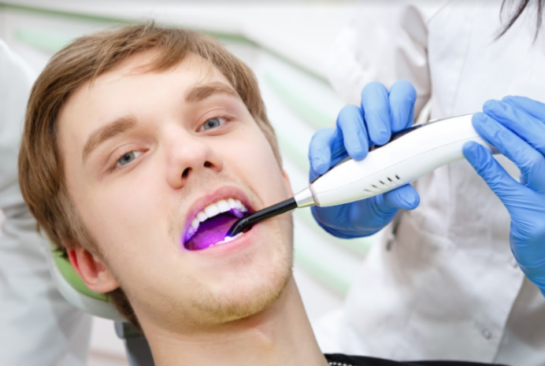- SHOWCASE

Modern Dental Practice: What Is Laser Dentistry?
Since the early 1990s, laser dentistry has offered a faster and more comfortable experience for certain dental procedures. The laser can reshape or remove hard and soft tissues without necessarily requiring the use of a drill.
Different Lasers for Hard and Soft Tissues
The type of laser used by a dentist depends on the procedure involved. Hard tissues like the teeth require a different laser than the gums. To shape and prep a tooth for a procedure such as repairing a filling or composite bonding, the dentist will use a hard tissue laser. This type of laser is absorbed by the water and minerals within the tooth.
Soft tissue lasers are used to address problems such as gum disease. The laser can penetrate through the soft tissue, being absorbed through water and hemoglobin. When penetrating the soft tissue, the laser can seal nerve endings — helping eliminate any discomfort or pain that may otherwise be experienced after the treatment.
Common Dental Procedures for Lasers
There are a few procedures where dentists may commonly use a laser to treat a dental condition. These include:
- Tooth decay – a laser can remove decay from within a cavity.
- Filling preparation – a dentist can use a laser to kill bacteria in a cavity before it is filled to enhance the prospects of a healthy tooth.
- Gum disease – lasers can be used on the soft tissue to kill bacteria and help reshape the gums during root canal treatment.
- Prevent tooth sensitivity – laser dentistry can seal the tubules on the roots of your teeth to prevent sensitivity.
- Crown lengthening – by using a laser a dentist can reshape the gum tissue and the bone to provide a better tooth structure to support a crown.
- Removing lesions – a laser can be used to remove lesions or cankers in the mouth. They can also be used to perform a biopsy or to remove benign tumors.
- Teeth whitening – a dentist can hasten the tooth whitening process by using a laser to activate the peroxide bleaching solution.
There are additional procedures where a dentist qualified in laser dentistry may recommend using a laser. These include:
- Gummy smiles – a laser may be used to reshape the gum tissue to prevent the gums from covering the teeth.
- Nerve regeneration – it may be possible to use a laser to help regenerate damaged nerves and blood vessels
- Cold sores – by using a laser to treat cold sores, you may be able to prevent the pain they cause as well as reduce healing time.
- Soft tissue folds – a soft tissue laser can remove the tissue folds around dentures without the need for sutures.
- Obstructive sleep apnea – a laser could help relieve the symptoms of this sleep disorder by reshaping the throat tissues if this is the cause of the breathing difficulties.
Are There Instances Where A Laser Can’t Be Used?
Yes, there are times when lasers cannot be used to treat dental issues. The main example is on a tooth that already has an existing metal amalgam filling.
A laser also is not an option for large cavities, filling cavities situated between teeth, and to fill cavities around old fillings.
Lasers are also not recommended when preparing teeth for the placement of bridges or to remove damaged or defective crowns.
Pros and Cons of Laser Dentistry
Using lasers is a relatively recent addition to modern dental practice. While there is much hope over its full potential, the field has its pros and cons as listed beneath.
Pros:
- can be less painful, reducing the need for anesthesia
- promotes blood clotting, leading to less bleeding
- can remove the need for sutures in some procedures
- by removing the need for a drill, can make process more comfortable for people with dental anxiety
- sterilizes the area where the laser is applied, reducing the risk of bacterial infection
- the focused beam of narrow light can cause less damage to surrounding tissues
- by removing decay and bacteria, a laser may preserve a healthier tooth
Cons:
- can’t use a laser on teeth with existing amalgam fillings
- lasers do not eliminate the need for anesthesia in all procedures
- surrounding conditions of the tissue within the oral cavity can disqualify lasers
- using a hard laser can risk damaging the tooth pulp
- a drill may still be needed to complete a filling and reshape or polish a tooth
- lasers can involve a risk from gum injury
- laser dentistry tends to be more expensive
The risks from lasers for dental procedures remains small. However, using the wrong wavelength or the wrong power level can result in damage to the gum tissues. Therefore, it is important to find a dentist qualified to use lasers and to listen to their recommendations. Not every procedure and not every person will be a candidate for dental treatment using lasers.
Sources:







